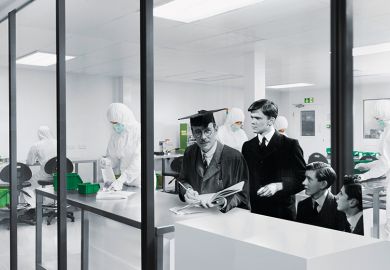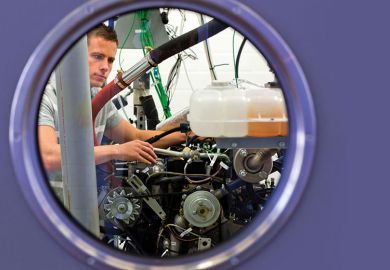View the full table of results or search our interactive table below
“I count myself lucky.”
This is the verdict of Maikel Pellens, a senior researcher at Germany’s Centre for European Economic Research (ZEW), on the benefits of working at a research institute, as opposed to a university.
No teaching duties or student assessment obligations mean that he can concentrate purely on research. The core funding the institute provides makes winning external funding less crucial to maintaining scientific momentum. And he enjoys working in a community of like-minded scientists, “many of whom are now friends” and who all work in similar fields.
The ZEW sits within the Leibniz Association – one of the four national networks of research institutes within Germany, alongside the Max Planck and Fraunhofer societies and the Helmholtz Association. These institutes account for more than a third of German public-sector research posts and consistently feature in the upper echelons of the Nature Index, which ranks research organisations on their volume of publications in high-quality journals.
By definition, institutes are excluded from global university rankings, but Germany’s institutes also figure reasonably prominently in an unofficial ranking of non-university and non-commercial research organisations produced for Times Higher Education by Elsevier. The ranking is based on field-weighted citation impact: a measure of citation impact that takes into account disciplinary norms. Where the global average is 1, the Leibniz Association as a whole scored 1.63 between 2013 and 2017, while the Max Planck Society, Germany’s highest-ranked institute group, scored 2.05. This places them outside the published top 150 (which includes many hospitals as well as standard research institutes) but inside the top 200.
Yet there is trouble in this apparent paradise. German institutes have come in for increasing scrutiny in recent months, on account of claims among a number of German politicians that their directors are overpaid and that the level of public funding they receive is not justified by their performance levels.
Pellens feels that working in an economics institute puts his research agenda in closer contact with “people who work on the ground: I can talk to them about what they are worried about at that moment, what problems they are trying to solve”. But Albert Rupprecht, research and education policy spokesman of the ruling CDU/CSU parliamentary group, said in June that “the previous achievements of [Germany’s] scientific organisations have not convinced us. Their output regarding the economy and society must be increased” – particularly regarding “products, applications and services”. He described the record of the Helmholtz Association – which, with 38,000 employees, is the country’s largest research network – as “anything but a success”.
Meanwhile, the Free Democratic Party (FDP) politician Thomas Sattelberger argued in an interview in June that Germany’s research institutes had become “lethargic” and “pretty fat cats”, and should receive more money only on the basis of proven increases in productivity levels – particularly, again, regarding commercial spin-offs.
But Pellens disagrees. He dismisses such complaints as a “huge generalisation…That’s not to say that I think there are no institutions that are not performing well, [but] a measure such as patents can only capture one angle [of an institute’s overall impact]…There are other things firms get from collaboration that we cannot measure.”
Moreover, he continues, while there is plenty of research showing the commercial impact of universities, there is much less regarding specialist institutes. “As always, data is a problem because it’s often confidential and that makes it really difficult to assess what’s going on,” he adds. For this reason, he thinks the attacks on institutes arise largely out of a “lack of understanding in the political sphere about what these institutes do”.
To prove his point, Pellens has produced a working paper highlighting how firms that do their research and development in partnership with one of the Fraunhofer institutes – which specialise in applied research – enjoy higher levels of growth, productivity and innovation.
“Fraunhofer draws a third of its funding from private firms, to the tune of €600 million [£535 million],” he notes. “Presumably, it would not maintain this [income] if it didn’t add value to the companies it contracts with.” Nor are the associations dedicated to basic research unable to demonstrate their value to the commercial sector: Pellens’ own Leibniz Association institute derived 44 per cent of its funding from private firms as well as science funders and governments in 2016, he says.
But scepticism is not confined to the political sphere. Thomas Sudhof, professor of molecular and cellular physiology at Stanford University and co-winner of the 2013 Nobel Prize in Physiology or Medicine, did his PhD at a Max Planck institute and returned briefly to the society as an institute director in the 1990s, before falling out with the society’s then president, Hubert Markl. His experiences in Germany and the US also make him doubt the efficacy of research institutes.
On the one hand, he says, “being part of a university can be considered a burden by a brilliant scientist because it requires dealing with a messy bureaucracy, justifying what you are doing – often to people who are not experts – talking to students who do not always show respect, and frequently having to make a case for getting funded. A beautiful, separate, well-funded research institute that just lets a scientist plod along undisturbed, like monks in a monastery, may in fact be better for that rare species of genius that thrives in isolation.”
However, there are “multiple factors that make universities better places for science”, he believes. They have “lots of different people to interact with”, for instance, and “lots of different opportunities for career development”. Moreover, “universities are much more creative and productive than research institutes, if you take into account that the vast majority of funding at a university does not go into research, but [university] services.”
The US, where Sudhof has spent much of his career, has plenty of research institutes of its own. Among them are the Howard Hughes Medical Institute’s Janelia Research Campus in Virginia. However, like the UK’s Wellcome Trust, HHMI also funds many researchers within universities. These include Sudhof himself, a Göttingen native, who believes that this approach leads to “much more productive and creative [science] than that produced by Max Planck directors”, for example – even though the Howard Hughes budget is less than half that of the Max Planck Society.
“There may be other reasons to maintain separate research institutes – for instance, national interests or security,” he says. “But for science as such, on balance, I feel the best model is to put the labs directly into the universities.”

The value of independent research institutes is also being called into question in other countries, too. In Russia, for instance, research has for decades been dominated by the Russian Academy of Sciences (RAS), which has more than 1,000 institutes and employs nearly 50,000 scientists. But following his re-election to the country’s presidency in May, Vladimir Putin announced targets to double the number of foreign students in Russian universities by 2024, and to create at least 15 world-class centres for education and research – specifically through cooperation between universities, research institutes and supporting businesses. Some institutes will remain independent, but the majority will be forced to form links with higher education institutes.
“We’ve come to believe that the model of a teaching-only university has no future, for multiple reasons,” says Andrei Volkov, an expert in education policy and deputy chairman of the Russian Excellence Council. Some of those reasons relate to specific problems with the RAS, such as its exclusive, “club-like structure” and its jobs-for-life culture, which limit the options for young scientists. But other reasons are more philosophical. They include a desire that university teaching staff be “at the frontier of knowledge”, and a belief that universities “cannot really serve the goal of responding to the big challenges” humanity faces without conducting high-quality research on their own premises.
A positive side-effect of this move, it is hoped, will be to help push Russian universities higher up in global rankings, which draw heavily on research performance data. The country’s Project 5-100, launched in 2012, has the specific aim of propelling five of the country’s institutions into the global top 100 by 2020. A rise in ranking positions would be important not only for a university’s sake, Volkov says, but also because it would be “an indicator that [Russia is] starting to play a more important role in the global division of academic labour: that we are doing something right”.
China – whose largest producer of research is the vast 60,000-researcher, 114-institute Chinese Academy of Sciences – is also pouring big money specifically into its universities, via its “Double First Class” project, which has run since 2015 and aims to expand significantly China’s tally of highly ranked universities by 2050. Last year, the country announced a list of 42 universities it will support to achieve “world-class” status via the programme.
A third country with a large number of research institutes and a corresponding concern about the position of its universities in world rankings is France. With more than 30,000 staff and an annual budget of €3.2 billion, the National Centre for Scientific Research (CNRS) is involved in roughly CNRS.fr/en/506.htm">half of all French research papers listed in bibliometric databases.
In 2010, France’s then-president Nicolas Sarkozy launched the Initiatives d’Excellence (Idex) programme, which has brought together various universities and research institutes into larger conglomerations known as ComUEs. However, the president of one of those conglomerations, Paris Sciences et Lettres – PSL Research University Paris, recently CNRS-head-dont-rip-french-recipe-research-success">told THE that he did not believe the CNRS held back the country’s universities any longer. Alain Fuchs, who himself led the CNRS from 2010 until 2017, pointed out that “90 per cent of [CNRS] laboratories are supported within universities, with more and more joint appointments being made”.
Of the CNRS’ almost 1,000 institutes, 25 are overseas. One of those is the Maison Française at the University of Oxford (MFO). French academics are not eligible for standard sabbaticals, so positions at the institute are highly sought after: there are about 150 applicants for three two-year positions. Successful candidates may be asked to do some teaching, but, according to MFO director Frédéric Thibault-Starzyk, its volume feels light by French university standards (where 200 teaching hours a year is standard) – especially given Oxford’s eight-week terms.
Thibault-Starzyk believes that his institute helps to promote French research and collaboration. Still, “we are a small institution so we always have to fight for our income and to convince people that what we do is beneficial, both for university culture and for France,” he says. “We have a fear that we always have to fight to exist.”
The MFO has traditionally been focused on the humanities. A chemist by trade, Thibault-Starzyk is the first hard scientist to direct it, and one of his missions is to expand interdisciplinary collaboration between MFO and Oxford academics. This approach is partly tactical, he says, since it is often easier for scientific institutes to support themselves financially.
This intermingling of institutes and universities is actually very common in many countries. Some of the top US research institutes on the list are tied very closely to universities. For instance, the Broad Institute, ranked second, is a collaboration between Harvard University and the neighbouring Massachusetts Institute of Technology. Less than a dozen “core members” have their labs at the institute, but it also encompasses nearly 200 “associate members”, based at one of the universities or their associated hospitals.
In the UK, meanwhile, independent institutes have also gone rather out of fashion. About 30 years ago, the UK government supported research within independent institutes, such as government laboratories, with the specific goal of delivering results for the economy, according to Peter Coveney, professor of physical chemistry at UCL and director of the university’s Centre for Computational Science. But “almost always their budgets withered under austerity”, with the result that a lot of them “just vanished”, leaving behind what would historically have been considered “rather a thin grouping”.
“People in the UK education sector are very wary of institutes,” Coveney notes. “They argue all the time that it’s important to have teaching and research coupled together.” The problem, from his point of view, is that university research is so heavily assessed, in exercises such as the research excellence framework, that it is only in institutes that researchers can take risks – including pursuing applied research.
“In this way it can be easier to work in a research institute as a scientist looking to explore a topic across different fields,” he says.
But even the UK institutes that still have formal independence often have institutional agreements with neighbouring universities – potentially exposing their researchers to the same assessment regimes, in addition to those imposed by the institute’s funders. There are, however, several advantages to such institute-university tie-ups: the universities get to claim the institute’s research as their own for assessment purposes, and also get some limited access to institute staff for teaching purposes. The institutes, meanwhile, benefit from the pulling power of university campuses and cities, and, specifically, get access to PhD students, whose relatively cheap labour is a boon to productivity. For instance, PhDs at the Medical Research Council’s fabled Laboratory of Molecular Biology and the Wellcome Trust’s flagship Sanger Institute are awarded by the University of Cambridge, while doctorates from London’s mighty Crick Institute – a landmark collaboration between the MRC, the Wellcome Trust and Cancer Research UK, which opened in 2016 – are awarded by one of its partner universities, UCL, Imperial College London or King’s College London.

The Crick’s neighbour, the Alan Turing Institute for data science and artificial intelligence, announced by then-chancellor George Osborne in 2014, involves no fewer than nine university partners. Osborne clearly enjoyed announcing a shiny new institute, but always in collaboration with universities; the National Graphene Institute, announced in 2011, is at the University of Manchester, for instance.
Many universities, in addition, set up their own interdisciplinary “institutes” within their own walls to focus on particular research challenges. However, these are not always well funded and are sometimes only virtual arrangements. Lee Cronin, Regius chair of chemistry at the University of Glasgow, would like to see more genuinely “institute-like” arrangements within universities, which, crucially, would offer permanent, full-time research-only positions: “This would mean that talented postdocs who might not want to run academic research groups were able to work as lifetime researchers.”
Perhaps unsurprisingly, most observers take the balanced view that research institutes and universities alike are important parts of a healthy research system, both scientifically and in terms of maintaining a happy, productive scientific workforce.
Another instance is Tony Cunningham, president of the Association of Australian Medical Research Institutes. He argues that the focus of his 49 member institutes on “improving health outcomes” – often regarding a particular disease or patient group – is what “makes them differ in many respects from universities, which will always have a much broader focus and will need to consider other things, such as student outcomes, university world rankings, the competing needs of different faculties and so on”. By contrast, within institutes, “a more concerted effort can be made to deliver outstanding research performance, as well as better outcomes for the end users of research” – namely, patients.
“In Australia, many medical research institutes provide a bridge between the broad interdisciplinary research in universities and clinical research in teaching hospitals, all within the one precinct,” he argues. Still, he regards universities as a vital part of the mix, and views the 38 per cent of funding from Australia’s National Health and Medical Research Council that goes to independent medical research institutes as fair.
“More than half the income of medical research institutes comes from non-government sources – such as philanthropy, commercialisation deals and international grants,” he adds.
The MFO, too, has a more unified future in mind. A legal partnership with Oxford is being discussed, whereby the university would underwrite the centre financially but allow it to retain its autonomy under the CNRS: “This legal partnership would help to stabilise the future of the MFO,” Thibault-Starzyk says.
As for Stanford’s Sudhof, he continues to maintain that universities are the key institutions when it comes to research efficiency and progress. “The classical university has an ethos that gives science a meaning: to produce knowledge for humanity, and to share it with humanity,” he says. “A university has intellectual breadth and mobility. It is, by definition, not an isolated place with a few specialists, but represents a broad intellectual and scholarly environment. This is ever-more important as science becomes specialised.”
But he also believes that the likelihood of independent institutes dying out completely is slim.
“Big and small separate institutes will survive because there are lots of people who like them better: governments because they can be controlled better, scientists because, as leaders of such institutes, they can be more ‘free’ or less accountable, and the public because they sound great. So I think they will survive just fine.”
| Rank 2018 | Institution | Country | Number of publications | Field-weighted citation impact |
| 1 | American Cancer Society | United States | 771 | 13.45 |
| 2 | Broad Institute | United States | 4,444 | 5.71 |
| 3 | Whitehead Institute for Biomedical Research | United States | 832 | 5.03 |
| 4 | International Agency for Research on Cancer | France | 1,720 | 4.8 |
| 5 | National Institute of Psychiatry Ramon de la Fuente Muñiz | Mexico | 606 | 4.26 |
| 6 | Wellcome Trust Sanger Institute | United Kingdom | 3,033 | 4.2 |
| 7 | Cancer Registry of Norway Institute of Population-Based Cancer Research | Norway | 656 | 4.02 |
| 8 | Finnish Institute of Occupational Health | Finland | 1,197 | 4.01 |
| 9 | CREAL – Centre for Research in Environmental Epidemiology | Spain | 886 | 3.99 |
| 10 | Dana-Farber Cancer Institute | United States | 9,351 | 3.86 |
| 11 | Howard Hughes Medical Institute | United States | 12,801 | 3.83 |
| 12 | European Molecular Biology Laboratory | Germany | 3,639 | 3.82 |
| 13 | Ontario Institute for Cancer Research | Canada | 723 | 3.78 |
| 14 | Cold Spring Harbor Laboratory | United States | 1,048 | 3.76 |
| 15 | Luxembourg Institute of Health | Luxembourg | 673 | 3.73 |
| 16 | International Centre for Diarrhoeal Disease Research Bangladesh | Bangladesh | 1,270 | 3.68 |
| 17 | Netherlands Institute for Developmental Biology | Netherlands | 616 | 3.64 |
| 18 | Swiss Institute of Bioinformatics | Switzerland | 1,709 | 3.61 |
| 19 | FOM – Institute of Subatomic Physics – NIKHEF | Netherlands | 1,974 | 3.57 |
| 20 | Institut Gustave Roussy | France | 4,009 | 3.56 |
| 21 | National Science Foundation | United States | 948 | 3.55 |
| 22 | Potsdam Institute for Climate Impact Research | Germany | 1,330 | 3.53 |
| 23 | National Bureau of Economic Research | United States | 2,614 | 3.48 |
| 24 | Netherlands Cancer Institute | Netherlands | 3,284 | 3.47 |
| 25 | Wellcome Trust | United Kingdom | 2,465 | 3.46 |
| 26 | Cardiovascular Research Foundation | United States | 790 | 3.39 |
| 27 | Hopital Dupuytren | France | 678 | 3.38 |
| 28 | IRCCS Materno Infantile Burlo Garofolo | Italy | 977 | 3.36 |
| 29 | Glenfield Hospital | United Kingdom | 823 | 3.33 |
| 30 | National Institute of Public Health | Mexico | 1,493 | 3.32 |
| =31 | Public Health Agency of Canada | Canada | 1,577 | 3.31 |
| =31 | Norwegian Institute of Public Health | Norway | 2,821 | 3.31 |
| 33 | The George Institute for Global Health | Australia | 1,881 | 3.3 |
| 34 | Memorial Sloan Kettering Cancer Center | United States | 12,482 | 3.29 |
| 35 | Institute of Cancer Research | United Kingdom | 2,299 | 3.27 |
| =36 | Box Hill Hospital | Australia | 972 | 3.2 |
| =36 | Scripps Clinic | United States | 681 | 3.2 |
| 38 | Institute for Systems Biology | United States | 525 | 3.17 |
| 39 | Folkhälsan Research Centre | Finland | 1,219 | 3.16 |
| 40 | South Australian Health and Medical Research Institute | Australia | 1,121 | 3.12 |
| 41 | Canisius Wilhelmina Hospital | Netherlands | 756 | 3.09 |
| 42 | Van Andel Research Institute | United States | 524 | 3.08 |
| 43 | International Institute for Applied Systems Analysis, Laxenburg | Austria | 1,289 | 3.06 |
| 44 | Swiss Tropical Institute | Switzerland | 2,197 | 3.05 |
| 45 | Italian Space Agency | Italy | 712 | 3.04 |
| 46 | Princess Margaret Hospital | Canada | 1,614 | 3.03 |
| 47 | European Institute of Oncology | Italy | 2,204 | 3.02 |
| =48 | Peter Maccallum Cancer Centre | Australia | 2,565 | 3.01 |
| =48 | Ludwig Institute for Cancer Research | Switzerland | 1,211 | 3.01 |
| =50 | Minneapolis Heart Institute | United States | 660 | 3 |
| =50 | Institute for Advanced Studies | United States | 1,452 | 3 |
| =52 | Cross Cancer Institute | Canada | 704 | 2.97 |
| =52 | Woolcock Institute of Medical Research | Australia | 643 | 2.97 |
| =54 | Churchill Hospital | United Kingdom | 1,640 | 2.93 |
| =54 | National Cancer Research Institute, Milan | Italy | 2,825 | 2.93 |
| =54 | Westerdijk Fungal Biodiversity Institute | Netherlands | 676 | 2.93 |
| =57 | Westchester Medical Center | United States | 581 | 2.92 |
| =57 | Trimbos Institute, Netherlands Institute of Mental Health and Addiction | Netherlands | 584 | 2.92 |
| 59 | Virginia Mason Medical Center | United States | 1,014 | 2.91 |
| 60 | California Pacific Medical Center | United States | 1,025 | 2.9 |
| =61 | Nagasaki Institute of Applied Science | Japan | 726 | 2.89 |
| =61 | Cancer Research UK | United Kingdom | 3,512 | 2.89 |
| =61 | Qatar Computing Research institute | Qatar | 793 | 2.89 |
| =61 | Mario Negri Institute for Pharmacological Research | Italy | 2,014 | 2.89 |
| 65 | IFAE – Institute for High Energy Physics | Spain | 1,171 | 2.88 |
| 66 | Niguarda Ca’Granda Hospital | Italy | 619 | 2.87 |
| 67 | Hamilton Health Sciences | Canada | 1,378 | 2.86 |
| 68 | Carmel Medical Center | Israel | 600 | 2.85 |
| 69 | Fred Hutchinson Cancer Research Center | United States | 6,424 | 2.84 |
| 70 | Royal Marsden NHS Foundation Trust | United Kingdom | 1,415 | 2.83 |
| 71 | Health Canada | Canada | 1,239 | 2.81 |
| =72 | Food and Agriculture Organization of the United Nations | Italy | 822 | 2.8 |
| =72 | National Institute of Chemical Physics and Biophysics, Tallinn | Estonia | 890 | 2.8 |
| =74 | Astronomical Observatory of Padua | Italy | 1,490 | 2.79 |
| =74 | Christiana Care Health System | United States | 896 | 2.79 |
| =74 | Translational Genomics Research Institute | United States | 655 | 2.79 |
| =74 | Osservatorio Astronomico Roma | Italy | 1,171 | 2.79 |
| 78 | Franciscus Gasthuis Zuyderland | Netherlands | 645 | 2.78 |
| =79 | Group Health Cooperative | United States | 1,382 | 2.77 |
| =79 | Denver Health | United States | 738 | 2.77 |
| =81 | South African Medical Research Council | South Africa | 2,807 | 2.76 |
| =81 | Zucker Hillside Hospital | United States | 558 | 2.76 |
| =81 | Medical Research Council | United Kingdom | 11,802 | 2.76 |
| =84 | World Health Organization | Switzerland | 5,801 | 2.75 |
| =84 | Salk Institute for Biological Studies | United States | 1,442 | 2.75 |
| =84 | Fox Chase Cancer Center | United States | 2,185 | 2.75 |
| =87 | Institute for High Energy Physics | Russian Federation | 2,277 | 2.72 |
| =87 | Cedars-Sinai Medical Center | United States | 5,567 | 2.72 |
| 89 | Mayo Clinic Florida | United States | 2,919 | 2.7 |
| =90 | Pasteur Institute, Lille | France | 1,244 | 2.69 |
| =90 | Catania Astrophysical Observatory | Italy | 601 | 2.69 |
| 92 | Washington Hospital Center | United States | 1,387 | 2.68 |
| 93 | Institute of Oncology, Warsaw | Poland | 1,729 | 2.67 |
| 94 | Armenian Academy of Sciences – Yerevan Physics Institute | Armenia | 1,710 | 2.66 |
| 95 | Babraham Institute | United Kingdom | 616 | 2.65 |
| =96 | Bill and Melinda Gates Foundation | United States | 724 | 2.64 |
| =96 | St Luke Hospital, Kansas City | United States | 751 | 2.64 |
| =96 | Royal Observatory | United Kingdom | 991 | 2.64 |
| =96 | Swiss Federal Institute for Forest, Snow and Landscape Research (WSL) | Switzerland | 2,065 | 2.64 |
| 100 | Partners HealthCare | United States | 755 | 2.62 |
| 101 | Hopital Beaujon | France | 1,383 | 2.61 |
| 102 | Haga Hospital | Netherlands | 581 | 2.6 |
| 103 | FIRC Institute of Molecular Oncology | Italy | 620 | 2.59 |
| 104 | Primary Children's Medical Center | United States | 1,592 | 2.58 |
| 105 | Swedish Medical Center | United States | 689 | 2.57 |
| 106 | Institut d’Astrophysique de Paris | France | 1,721 | 2.56 |
| =107 | Lawrence Berkeley National Laboratory | United States | 16,633 | 2.55 |
| =107 | Warneford Hospital | United Kingdom | 758 | 2.55 |
| =107 | CRG – Centre for Genomic Regulation | Spain | 1,194 | 2.55 |
| 110 | Giovanni Pascale National Institute for the Study and Treatment of Tumours | Italy | 1,415 | 2.54 |
| 111 | Eurecom Institute | France | 797 | 2.53 |
| =112 | German Centre for Cardiovascular Research (DZHK) | Germany | 2,538 | 2.51 |
| =112 | Australian Institute of Marine Science | Australia | 997 | 2.51 |
| =114 | Connecticut Agricultural Experiment Station | United States | 567 | 2.5 |
| =114 | Met Office | United Kingdom | 1,720 | 2.5 |
| 116 | Bernhard Nocht Institute for Tropical Medicine | Germany | 602 | 2.49 |
| =117 | La Jolla Institute for Allergy and Immunology | United States | 751 | 2.47 |
| =117 | Addenbrooke’s Hospital | United Kingdom | 4,194 | 2.47 |
| =117 | National Institute of Public Health and the Environment | Netherlands | 3,345 | 2.47 |
| =117 | Auckland City Hospital | New Zealand | 1,438 | 2.47 |
| =121 | Telethon Foundation | Italy | 678 | 2.46 |
| =121 | Walter and Eliza Hall Institute of Medical Research | Australia | 940 | 2.46 |
| 123 | Baker Heart Research Institute | Australia | 1,890 | 2.45 |
| =124 | Catalan Institute of Oncology | Spain | 1,809 | 2.44 |
| =124 | Jackson Laboratory | United States | 871 | 2.44 |
| 126 | Perimeter Institute for Theoretical Physics | Canada | 1,991 | 2.43 |
| =127 | St Jude Children’s Research Hospital | United States | 3,889 | 2.42 |
| =127 | Health Protection Agency | United Kingdom | 881 | 2.42 |
| =127 | European Space Astronomy Centre | Spain | 1,029 | 2.42 |
| =130 | National Institutes of Health | United States | 42,773 | 2.41 |
| =130 | Danish Cancer Society | Denmark | 1,403 | 2.41 |
| =130 | Georges-Francois Leclerc Centre | France | 2,108 | 2.41 |
| =133 | Queensland Institute of Medical Research | Australia | 2,574 | 2.4 |
| =133 | German Institute of Human Nutrition | Germany | 895 | 2.4 |
| =133 | Wistar Institute | United States | 666 | 2.4 |
| =136 | IDIBAPS – August Pi i Sunyer Biomedical Research Institute | Spain | 5,101 | 2.39 |
| =136 | The Francis Crick Institute | United Kingdom | 1,953 | 2.39 |
| =136 | National Renewable Energy Laboratory | United States | 3,687 | 2.39 |
| =139 | Roswell Park Cancer Institute | United States | 2,736 | 2.38 |
| =139 | Fermi National Accelerator Laboratory | United States | 3,605 | 2.38 |
| =139 | St Antonius Hospital | Netherlands | 1,552 | 2.38 |
| =142 | European Centre for Medium-Range Weather Forecasts | United Kingdom | 720 | 2.37 |
| =142 | Rijnstate Hospital | Netherlands | 707 | 2.37 |
| =144 | Cordeliers Research Centre | France | 964 | 2.36 |
| =144 | Centers for Disease Control and Prevention | United States | 15,754 | 2.36 |
| =146 | Carnegie Institution of Washington | United States | 3,359 | 2.34 |
| =146 | ICREA (Catalan Institute for Research and Advanced Studies) | Spain | 7,552 | 2.34 |
| =146 | Singapore National Eye Center | Singapore | 1,513 | 2.34 |
| =146 | National Center for Atmospheric Research | United States | 3,854 | 2.34 |
| =146 | Woods Hole Oceanographic Institution | United States | 3,414 | 2.34 |
| Other notable institutes: | |||
| Scripps Research Institute | United States | 5,182 | 2.32 |
| Weizmann Institute of Science | Israel | 7,616 | 2.23 |
| National Institute for Health and Welfare | Finland | 3,554 | 2.21 |
| Rutherford Appleton Laboratory | United Kingdom | 5,204 | 2.12 |
| Australian Research Council | Australia | 2,217 | 2.11 |
| Max Planck Society | Germany | 57,711 | 2.05 |
| Helmholtz Association | Germany | 88,308 | 1.8 |
| National Institute for Health and Medical Research (INSERM) | France | 59,842 | 1.74 |
| Tata Institute of Fundamental Research | India | 5,101 | 1.67 |
| Leibniz Association | Germany | 23,518 | 1.63 |
| CSIC (Spanish National Research Council) | Spain | 56,268 | 1.57 |
| CNRS – National Centre for Scientific Research | France | 195,653 | 1.4 |
| Fraunhofer Society | Germany | 20,113 | 1.35 |
| Chinese Academy of Sciences | China | 243,762 | 1.29 |
Methodology
Institutes and hospitals are ranked on the basis of their field-weighted citation impact, calculated using Elsevier’s SciVal tool, between 2013 and 2017. Research organisations that produced fewer than 500 research papers during this period are excluded. Field-weighted citation impact is a normalised measure of citation impact where citations are normalised according to discipline, publication type (article, review, letter, etc) and age of publication, such that papers are only compared against others of the same type in the same field and in the same publication year. Hence, although there are many medical research facilities in the ranking, this reflects their abundance, rather than the fact that medical research is typically more highly cited than research in many other fields. The global average is 1, so a field-weighted citation impact of 2 would indicate a citation impact that is double the world average. Institutes that are part of a network, such as Max Planck Society institutes, have been grouped together.
Note: The official name for Luxembourg Institute of Health was updated from CRP-Santé on 4 December 2018.
POSTSCRIPT:
Print headline: In perfect isolation?
Register to continue
Why register?
- Registration is free and only takes a moment
- Once registered, you can read 3 articles a month
- Sign up for our newsletter
Subscribe
Or subscribe for unlimited access to:
- Unlimited access to news, views, insights & reviews
- Digital editions
- Digital access to THE’s university and college rankings analysis
Already registered or a current subscriber?








